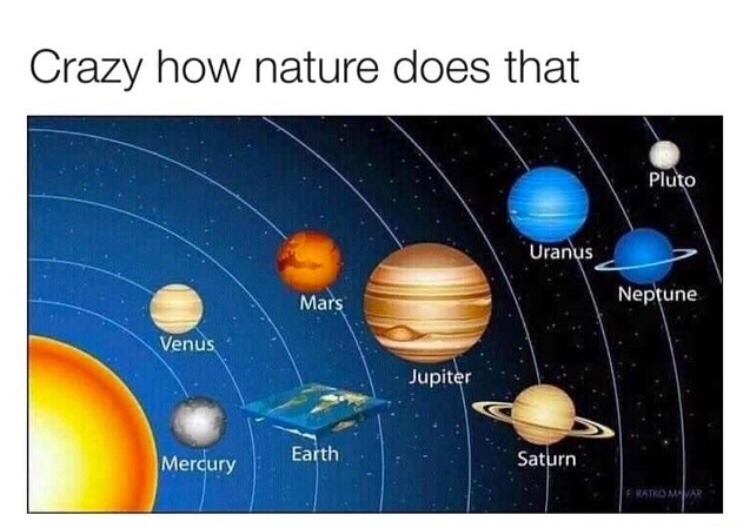Squish Like Grape
You are here
How Do We Know the Shape of the Earth?
Primary tabs
In the early 2000s, Thomas Friedman examined the effects of globalization and published his ideas in a book titled The World Is Flat. He meant it metaphorically, arguing in part that the information revolution enabled skilled workers in Malaysia or India to compete for jobs formerly held by first-world workers, and technologies such as cell phones and internet connectivity enabled them to work these jobs without leaving their home countries. The increase in personal freedoms after the collapse of Communism also contributed to this trend, according to Friedman.
But in the late 2010s we are seeing an entirely different sort of flattening of the world, as conspiracy theorists around the globe spread their belief that the earth is not a sphere. Many of the same technologies Friedman highlighted have also contributed to this very different sort of flattening.
The same impulse that led people to rise up against totalitarian governments has also led them to question mainstream science. The same communication tools that allow us to connect with outsourced workers half a world away also allow conspiracy addicts to test their ideas in an echo chamber. And the same global marketplace that provides opportunities for highly skilled workers in poor countries takes those opportunities away from low-skilled workers in rich countries. When too many frightened people come together with too much time on their hands, conspiracy theories happen.
If it were simply a matter of getting all the facts, flat earthism would never have gotten off the ground. There are a number of ways any of us can personally observe that the earth is spherical. Look at the shadow of the earth on the moon during a lunar eclipse. It's not flat.
Go to a dock and watch boats disappear over the horizon. The horizon exists because the earth is curved, and objects beyond that point are not in a direct line of sight from us. The boat appears to sink into the water as it disappears around the curve of the earth.
Climb a tree, or go up to a high floor in a tall building or to the top of a hill, and note how much farther you can see. That's because you are at an angle that lets you see more of the earth's curve.
Take a drive away from city lights at night. About 4-5 miles should be far enough to push the lights below the horizon, but you may need to go a little farther depending on the terrain. We can see starlight that has traveled billions of light years; there is no reason, if the earth were flat, why we shouldn't be able to see city lights from a few miles away. Astronauts orbiting the earth can see them from hundreds of miles above. We can't see them from the ground because the earth is curved.
Get a friend to help, and plant two sticks in the ground a good distance apart (several miles, if possible) and measure the length of their shadows at the same time. The shadows will be different lengths because the curvature of the earth means the sun strikes at different angles in different places. The Greek philosopher Eratosthenes used this method more than 2200 years ago to not only prove the earth is a sphere, but to measure its circumference.
Ask a mapmaker. It is notoriously difficult to render our planet's curved surface on a flat map. A number of projection systems have been invented to try to overcome this problem, but every system has its weaknesses. The earth is much easier to render as a globe.
Or ask a NASA engineer. Cell phones and GPS would not work on a flat planet. Satellites rely on the curvature of the earth to stay aloft. Essentially, they are released from their launch vehicles with enough forward momentum that as they fall, the earth below curves away at the same rate. The engineers take the earth's size and shape into account when launching these satellites; if our planet were not spherical, their math wouldn't work, and their satellites would crash into the ice wall at the rim.
Even young-earth creationists can't buy into the flat earth conspiracy, despite the fact that the two groups draw some of their ideas from the same biblical passages.
So why has flat earthism gained popularity in recent years, despite the solid evidence our planet is a sphere?
If you're asking that question, you were never likely to believe in conspiracy theories in the first place. Conspiracy theorists don't arrive at their beliefs through observation or reason, and they won't be dissuaded from those beliefs via observation or reason.
What sets conspiracy theorists apart from people who are simply uninformed or mistaken is the extent to which the conspiracy theorists' beliefs form a part of their identity. The conspiracy theory provides the believer with three psychological benefits: a sense of control, a feeling of certainty, and a positive self image. When a person is isolated, faces an uncertain future, or is dealing with forces outside their control, a belief in a flat earth can bring a sense of comfort and community.
As a result, the seven tests I listed above won't convince anyone the earth is spherical unless they already trust that it is. Conspiracy theorists faced with opposing evidence will perceive it as an attack on their identity, and will simply retreat further into their echo chamber.
So is there any way to combat the growth of conspiracies? Some experts say no. Ultimately, a conspiracy theorist would need to learn to live with uncertainty, to not need to be in control, and to find a new community that affirms their positive self image.
That's why science journalist Elfy Scott suggests we listen empathetically to conspiracy theorists, not to excuse or legitimize their beliefs, but to break down the walls and the "us vs them" mentality that encourages conspiracy theories in the first place. This approach may or may not achieve anything, but it's likely the only way to get through to a flat earther.
Theme by Danetsoft and Danang Probo Sayekti inspired by Maksimer



